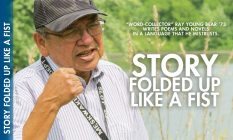
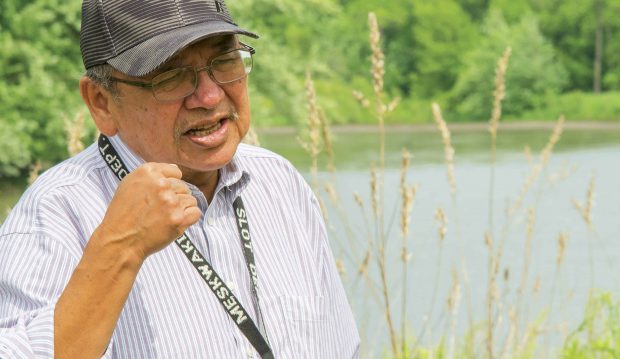
IN THE MESKWAKI LANGUAGE, There is no word for poem. So poet and novelist Ray Young Bear ’73 made up his own: pekwimoni, a word that translates roughly as “story folded up like a fist.”
It’s a word that seems perfectly suited to the interwoven cultural imagery that fills his work. “My poems are therefore origami,” he explains, “large stories that have been compressed with multiple layers of images and messages. They can be complicated or simple, but they’re replete, once the key is turned, with Algonquian-based history.”
Algonquian is the group of Native American languages—and cultures—to which Meskwaki belongs. The Meskwaki, or “People of the Red Earth,” originated in the Great Lakes region of what is now New York and have a long, tragic history of being driven westward, all the way to Kansas. Finally, in the 1800s, they doubled back to central Iowa, bought a chunk of prairie beside the Iowa River and took root there in what is now the Meskwaki Settlement.
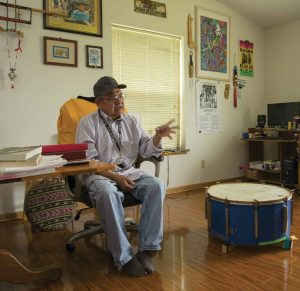 Meskwaki language is spoken today by only a few hundred people, and Young Bear is grateful to be among them. Since his formal education took place entirely in English, however, he didn’t learn to read and write Meskwaki until much later, in adulthood. Today he takes pride in being one of the few Native American authors with literary mastery of their native tongue. “I’ve got contemporaries who are very famous who may not be well versed in their language, but I happen to be halfway proficient. That’s a rarity, in my opinion.”
Meskwaki language is spoken today by only a few hundred people, and Young Bear is grateful to be among them. Since his formal education took place entirely in English, however, he didn’t learn to read and write Meskwaki until much later, in adulthood. Today he takes pride in being one of the few Native American authors with literary mastery of their native tongue. “I’ve got contemporaries who are very famous who may not be well versed in their language, but I happen to be halfway proficient. That’s a rarity, in my opinion.”
In his early days of writing poetry, he recalls, he usually thought his verses out first in Meskwaki and then rewrote them in English. “But as I started growing up, getting mature, I realized that oftentimes it was just the opposite. It eventually got to the point where, you know, I was writing far too much English; then I sometimes had to go back and start redoing stuff in Meskwaki again.”
Indeed, the two languages flow together in many of his recent poems. Lines of Meskwaki appear here and there among his verses, and his newest volume—Manifestation Wolverine: The Collected Poetry of Ray Young Bear, a compilation of his earlier collections plus a slate of new poems—includes works like “Three Translated Poems for October,” originally composed in Meskwaki and then translated into English, as well as a series of old Meskwaki peyote and social songs.
GRANDMOTHER
if I were to see
her shape from a mile away
i’d know so quickly
that it would be her.
the purple scarf
and the plastic
shopping bag.
if i felt
hands on my head
i’d know that those
were her hands
warm and damp
with the smell
of roots.
if i heard
a voice
coming from
a rock
i’d know
and her words
would flow inside me
like the light
of someone
stirring ashes
from a sleeping fire
at night.
But though he uses English with poetic skill and depends upon it to bring his work to a wide range of readers, he still regards it as an alien tongue, part of a culture that subjugated, displaced and nearly wiped out his own. “Sometimes I wonder how much I should accept the English language, because it is, after all, colonialism in progress,” he muses. “Maybe I don’t want to accept the English language because it would mean that we’re defeated. You know, you don’t want to succumb to the civilization that almost killed you.”
Old Bear, Young Bear
The slightly worn La-Z-Boy recliner in Young Bear’s living room appears in some of his poems as a place of visions. It’s where he sits when he’s seeking spiritual guidance, and a number of his poems originated in scenes dreamt there.
Today, however, he has ceded that place of honor to his guest and retreated to a desk chair against the wall, where he sits gazing out at the riot of springtime greenery as he talks about his life and the culture and religion that inspire much of his poetry. On the wall behind him are framed photos of his six adopted children, along with concert posters, Meskwaki artifacts and memorabilia from poetry readings across the country. To his left is a big ceremonial drum, on which he occasionally taps out a rhythm to illustrate a story.
“Most of what I know with regard to language, religion and culture comes from my grandmother and my father,” he says. “Both of them were quite religious, other than the fact that they had different, you know, political beliefs.”
By “different” he means bitterly opposed. His parents were members of powerful clans that represented opposite poles of tribal politics—the traditional and the progressive. “My parents were star-crossed lovers like the Capulets and the Montagues,” he says. “My mother is an Old Bear from the conservative, traditional chief-in-absentia line of beliefs. My father came from the progressive Young Bear faction that believed in working with outside society and getting ahead. And so the Old Bears and the Young Bears were against each other, and then my parents fell in love and had me.”
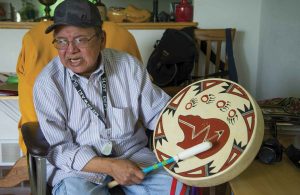
With his parents separated by political feuding, Young Bear lived until the age of 10 with his grandmother, Ada K. Old Bear, a seminal figure in his life and work. Indeed, the very first poem in his first published collection, Winter of the Salamander, is titled “Grandmother” and begins with the words: “if I were to see / her shape from a mile away / i’d know so quickly / that it would be her.”
“My grandmother didn’t speak any English,” he says, “so I’d converse with her in Meskwaki. She was the one who basically began outlining the world order for me to understand just exactly why we are here.”
Those traditional beliefs still profoundly color his view of the world. “Animism is probably the best way I can describe my beliefs,” he says. “When I go into an elementary school, or even graduate school level, the analogy I give them is: If you see a tree outside, for you and me, we can look at it scientifically and also for aesthetic reasons. But for Meskwakis, they look upon the tree as a protector, as a remnant of the gods that were left here after the first time the world was obliterated.”
The Accidental Poet
Starting in the seventh grade, Young Bear entered the public schools of Tama, Iowa. “That was the first time I had Caucasians for classmates,” he recalls, “and that was when I realized that I was behind in my academics.”
THIS HOUSE
i begin with the hills
lying outside the walls
of this house.
the snow and the houses
in the snow begin somewhere.
the dogs curled against each
other must feel that they own
the houses, the people
in each house must feel
they own the dogs
but the snow is by itself
piling itself over everything.
i keep thinking of comfort
such as a badger stretched over
a house with its guts pulled
out. its legs over each corner.
it is truly a dream to tie down
a skinned badger like a tent over
a house, watching it shift
as the wind changes direction
like the cylinders of pistols,
the holes of magnums turning
people inside out.
my young wife turns under
the yellow blanket in her sleep.
she wishes to be left alone,
closes herself within the dark
of her stomach, cups her hands
and sees what is ahead of us.
she senses i will die long before
the two of them, leaving her
without a house, without roomlight.
the yellow blanket, the house
and its people cover her.
the clothes she wears cover her.
the skin of her body covers her.
the bones cover her womb.
the badger feels it owns the womb,
protects the unborn child,
encircles itself to a star
and dies in our place.
He recalls an essay assignment in particular—one he thought he’d aced. “The teacher came up to me and said, ‘Ray.’ She kind of whispered it and said, ‘Do you know what you did?’ And I said, ‘What?’ And I thought, ‘Uh-oh.’ She said, ‘You’ve written a poem, not an essay.’ I said, ‘Okay.’ And she walked away. But I didn’t know what that meant. What’s a poem?”
The answer would come to him through popular songs sung by the Beatles and Simon and Garfunkel. He recalls becoming so fascinated by the lyrics of “The Sound of Silence” that he wrote them down on a piece of paper and carried them around in his billfold. Soon Young Bear would begin to write more intentionally, and poetry would shape his life in surprising ways.
For example, it was a poem that brought him halfway across the continent to Pomona College.
The poem, he says, “was basically a proclamation of my native identity or something like that, a very awkward, very raw poem that I had written in the ninth or 10th grade.” But when he was a high school senior, it was printed in a magazine published by the Upward Bound program, and soon thereafter, he received a surprising letter. “It said, ‘I read your poem, and I was wondering if you’d like to come to school at Pomona College in California. We can offer you a $30-a-month stipend and travel to and from home whenever necessary,’ and so forth.”
It sounded too good to pass up, so he took the ticket the College sent him, and with $25 in his pocket and a paper bag full of snacks, he boarded the train for a two-day trip out West.
At Pomona, he soon found himself in over his head academically—some classes he thrived in; others he found utterly incomprehensible. Today he suspects that he underestimated his own academic abilities and sabotaged his own college career. In any case, after two years of focusing on the classes he loved and ignoring the others, he dropped out and returned home. But he still remembers those two years as some of the most influential on his poetry, mainly because of the poets he encountered on the Pomona campus.
“I attended every poetry reading that I could,” he says. “And they had lots of great poets—nontypical poets like Charles Bukowski. He was the one that really got me interested in bluntness and being, you know, rude.” He also remembers meeting classmates and fellow budding poets Brenda Hillman ’73 and Garrett Hongo ’73 and spending an increasing amount of time alone, writing poetry. “In Manifestation Wolverine, the first 60 or 70 pages are all from Pomona,” he says. “So that was really a prolific time.”
After Pomona, he became a college hopper, spending time at the University of Iowa, Grinnell College, Northern Iowa University and Iowa State University, taking what he wanted from each while resisting requirements that would have led to a degree.
THE SIGNIFICANCE OF A WATER ANIMAL
Since then I was
the North.
Since then I was
the Northwind.
Since then I was nobody.
Since then I was alone.
The color of my black eyes
inside the color of King-
fisher’s hunting eye
weakens me, but sunlight
glancing off the rocks
and vegetation strengthens me.
As my hands and fingertips
extend and meet,
they frame the serene
beauty of bubbles and grain—
once a summer rainpool.
A certain voice of Reassurance
tells me a story of a water animal
diving to make land available.
Next, from the Creator’s
own heart and flesh
O ki ma was made:
the progeny of divine
leaders. And then
from the Red Earth
came the rest of us.
“To believe otherwise,”
as my grandmother tells me,
“or to simply be ignorant,
Belief and what we were given
to take care of,
is on the verge
of ending…”
Through it all, he continued to write, though he still refused to think of himself as a poet. In fact, when the University of Dakota Press, which had printed a couple of his poems, offered to publish his chapbook, “that scared me silly,” he recalls. “I only had 30 or 40 poems, and I thought, ‘I’m just a young man trying to write poetry, and it’s imitation. It’s not real.’”
Ironically, it was his traditional grandmother who encouraged him to continue to develop his burgeoning talent with the English language.
“By the time I got to 30 years of age, she began to say, ‘You should use your abilities to write about the history of your uncles and your grandfather, and how he purchased this land in 1856. And the only way you can communicate that is to write in English.’ Which floored me because, at first, she was the one saying, ‘Don’t learn anything, grandson, from the school,’ when she sent me to school, ‘because the whites are always trying to steal our language.’”
Vision Quests
Even today, despite his success as a writer, with four books of poetry and two novels under his belt, Young Bear shies away from referring to himself as a poet. He prefers to call himself a “word collector.”
“A word collector is primarily someone like myself who is bilingual,” he explains, “who is interested in the artistic communication process with the English language but doesn’t use it on an everyday basis. So it’s necessary for me to investigate these words and to see how I can implement them within my work.”
Much like a scrap metal artist, he says, he collects verbal scraps and reassembles them into art.
Even beneath the words, he refuses to take full credit for the images and ideas that make up his poetry. Many of them, he explains, come to him in dreams. “I tend to view myself a lot more these days as somebody who is basically channeling information,” he says. “My grandmother would always say, ‘You and I are protected by spirits invisible to us. They are always around us,’ And so I believe that part of the reason I am able to write these things without any academic foundation is the fact that I’m simply channeling those energies that have been here before.”
To some, that may sound metaphorical, but Young Bear couldn’t be more literal. Indeed, in recent years, he has become more and more involved in trying to use his ability to channel those spiritual connections for more mundane purposes, like solving crimes.
THREE TRANSLATED POEMS FOR OCTOBER
Old woman, I hope that at least
you will watch me in the future
when I am an elderly man—
so my baggy clothes
do not catch fire
when I socialize
with the young people
as they stand around
the campfire intoxicated.
Of course, I will tell them
worldly things.
/ / /
Now that the autumn season
has started, one suddenly
realizes the act of living
goes fast.
Sometimes the spring
is that way too:
the green so quick.
Thirty-two years of age I am.
Box elder leaves are being shaken
by the cold rain and wind.
In the tree’s nakedness
there stands a man,
visible.
/ / /
Although there is yet
a lot of things to do,
surprisingly, I have this urge
to go fishing.
They say the whites
in town will pay
one hundred dollars
to whoever catches
the largest channel catfish
or flathead.
You know I like to fish.
We could invite and feed
lots of friends.
Plus, purchase
a cast iron woodstove
since the business committee
has ignored our weatherization
application, but Bingo
is on the agenda.
It began with the murder of his brother in 1992, an unsolved crime he would fictionalize in his first novel, Black Eagle Child. “We contacted a psychic then in Dallas, Texas, who had some insights into Meskwaki clan names and some teenage suspects,” he recalls. “Over the years, my parents always believed these suspects would slowly kill themselves with drugs and alcohol. They got away, but perhaps not really.”
A few years later, after watching the news about three missing campers in Yosemite Park, he fell asleep in his La-Z-Boy and dreamt that he was one of the women, talking to a mysterious character through a car window. He took note of the license plate on a nearby car, but forgot it upon waking. The next day, he returned to his La-Z-Boy for a vision quest. “I was able to pin the license down and forward the info to the Sacramento FBI,” he recalls, though he has no idea if anyone ever took him seriously.
But the experience also served his poetry, inspiring a poem called “Three Brothers.”
The vision quests and the “word-collecting” poetry are all part of what Young Bear terms his experimental approach to life and to literature. “There’s no mold; there’s no pattern that I have,” he says. “It’s just an experiment. Everything that I do, almost, is an experiment. That’s what I like about poetry, because, you know, you can go back to something and rewrite it and change it over and over again. I’ve been working on some of my poems for 10 years.”
First Language
Maybe it was inevitable that Young Bear, caught from an early age in the tug-of-war between the traditional and the progressive, would be conflicted about the role of the two languages that have shaped his life as a Meskwaki and a poet. Though he continues to work on his poetry in English, as well as the third volume of his Black Eagle Child trilogy, he is also hard at work on a volume of nonfiction—a combination memoir and Meskwaki history. More and more, he is convinced that the true value of his work will be in whatever power it has to help preserve Meskwaki culture, religion and language.
“Culturally, with tribal languages predicted to die, poetry might be the vehicle against linguistic atrophy,” he muses. Still, the poet who refuses to think of himself as a poet continues to caution himself against taking his own literary ambitions too seriously.
“I wish I had met and been influenced by a person like myself, that fall in 1969,” he says, “who would’ve told me: ‘Hey, young Indian man, you can write and compose poems in English, yes, and you may eventually do it well. However, English isn’t your God-given language. Learn from it as much as you can, but always keep in mind that the first language that gave you animistic insights can’t be found in English. Foremost, English is a language that was used to convert us. In time, those colonial-based persuasions will reverse. Many will realize, even the best writers, that our first languages are key to survival and identity. As your grandmother probably told you, the Meskwaki creator doesn’t speak English. When he asks you what you have done, I can assure you, son, he won’t care about your books in English nor whether your life’s goal was to write a best-seller.’”
—Photos by Mark Wood
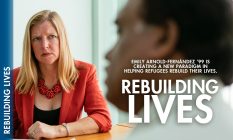
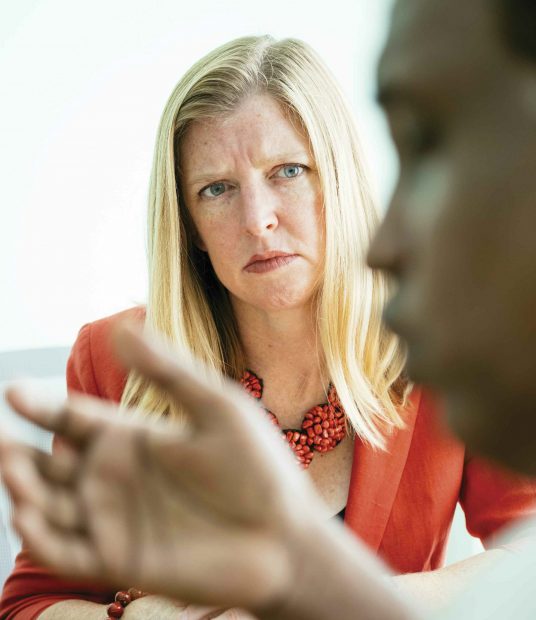

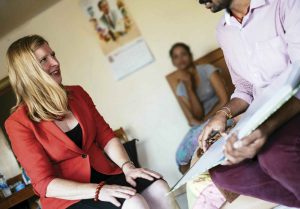






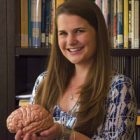
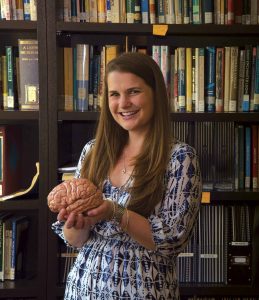

 In high school, follow your mother’s example and get involved in community service, volunteering at a food bank and local homeless shelter. Fall in love with the work partially because you find it fulfilling and have a deep interest in understanding the problems of the people you’re helping.
In high school, follow your mother’s example and get involved in community service, volunteering at a food bank and local homeless shelter. Fall in love with the work partially because you find it fulfilling and have a deep interest in understanding the problems of the people you’re helping. Know that you don’t want to follow in your brother Nick’s footsteps at Pomona College, but end up deciding it’s the best place for you anyway. And though you’ve always thought philosophy was abstract and boring, take a first-year seminar with Professor Julie Tannenbaum in medical ethics and discover that the field deals with intriguing real-world challenges.
Know that you don’t want to follow in your brother Nick’s footsteps at Pomona College, but end up deciding it’s the best place for you anyway. And though you’ve always thought philosophy was abstract and boring, take a first-year seminar with Professor Julie Tannenbaum in medical ethics and discover that the field deals with intriguing real-world challenges. Love your class in forensic psychology with Claremont McKenna College Professor Daniel Krauss so much that you end up as his research assistant. Major in both philosophy and cognitive science because you see them as two ways of understanding human behavior; then spend a summer with Harvard’s Mind/ Brain/Behavior program in Trento, Italy.
Love your class in forensic psychology with Claremont McKenna College Professor Daniel Krauss so much that you end up as his research assistant. Major in both philosophy and cognitive science because you see them as two ways of understanding human behavior; then spend a summer with Harvard’s Mind/ Brain/Behavior program in Trento, Italy. Inspired by a lecture by author/activist Bryan Stevenson on mass incarceration, follow his advice about getting “proximate” to the problem. Spend a summer working behind barbed wire at Patton State Hospital, a psychiatric facility in the California correctional system. While there, take an interest in psychopathy, which you come to believe is misunderstood.
Inspired by a lecture by author/activist Bryan Stevenson on mass incarceration, follow his advice about getting “proximate” to the problem. Spend a summer working behind barbed wire at Patton State Hospital, a psychiatric facility in the California correctional system. While there, take an interest in psychopathy, which you come to believe is misunderstood. As a senior, write two theses on the subject of psychopathy—an examination of the ethical theory of the blameworthiness of psychopaths for your philosophy major, and a study of inhibition deficits in high-functioning psychopaths for your “cog-sci” major.
As a senior, write two theses on the subject of psychopathy—an examination of the ethical theory of the blameworthiness of psychopaths for your philosophy major, and a study of inhibition deficits in high-functioning psychopaths for your “cog-sci” major. Conclude that psychopathic traits should be treated as a mitigating factor in both moral and legal domains, and decide you want to study the subject further to be able to influence public policy. Gain admission to a top Ph.D. psychology program at UC Davis with a professor whose research offers opportunities to pursue your chosen work into the future.
Conclude that psychopathic traits should be treated as a mitigating factor in both moral and legal domains, and decide you want to study the subject further to be able to influence public policy. Gain admission to a top Ph.D. psychology program at UC Davis with a professor whose research offers opportunities to pursue your chosen work into the future.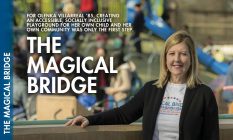
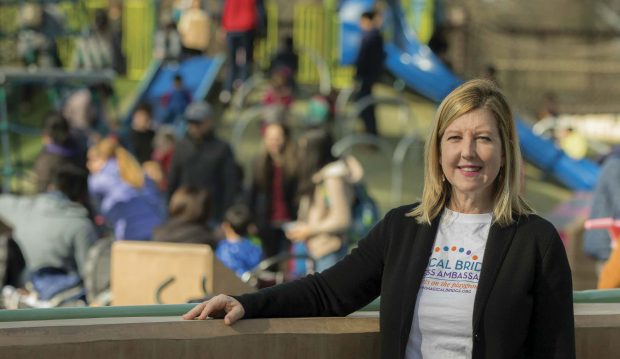


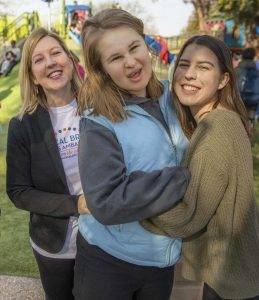
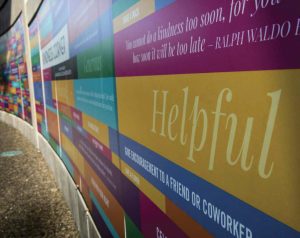
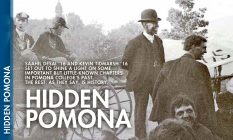
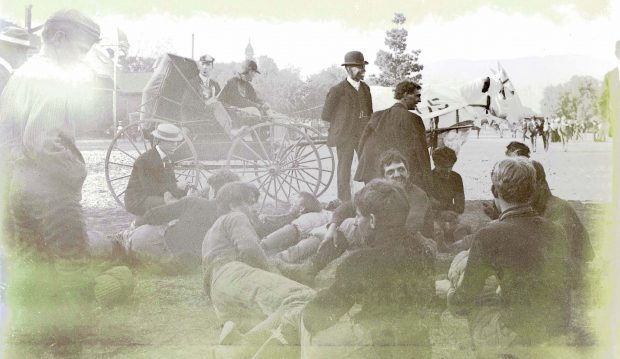
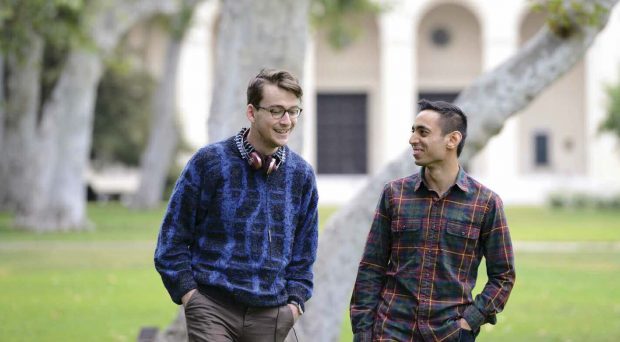
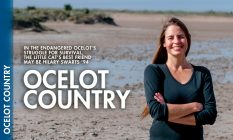

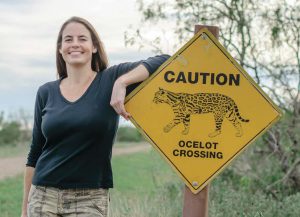
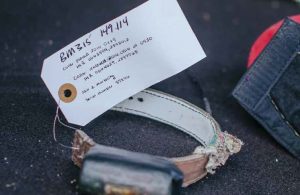
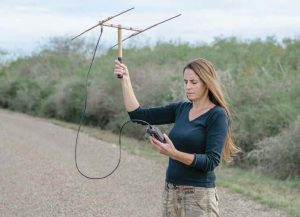
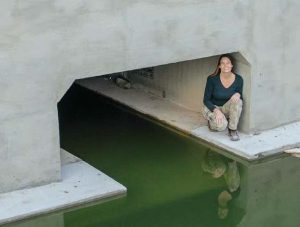

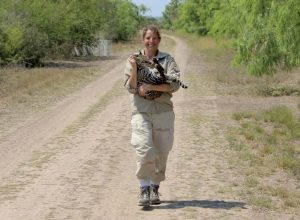
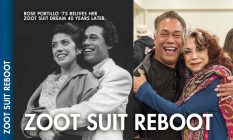

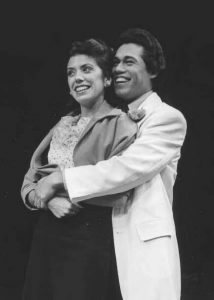 The play, written by Valdez, is based on the Sleepy Lagoon murder trial and the Zoot Suit Riots that occurred in early 1940s Los Angeles. The play tells the story of Henry Reyna and the 38th Street gang, who were tried and found guilty of murder, and their subsequent journey to freedom.
The play, written by Valdez, is based on the Sleepy Lagoon murder trial and the Zoot Suit Riots that occurred in early 1940s Los Angeles. The play tells the story of Henry Reyna and the 38th Street gang, who were tried and found guilty of murder, and their subsequent journey to freedom.
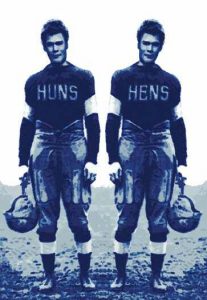 1. Huns to Hens
1. Huns to Hens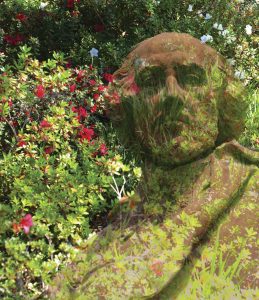 2. The Shakespeare Garden
2. The Shakespeare Garden 3. Things That Go Bump
3. Things That Go Bump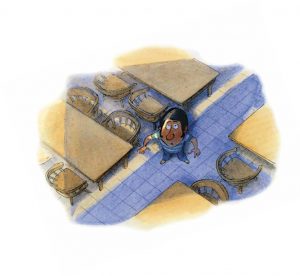 4. The Flying Sailboat
4. The Flying Sailboat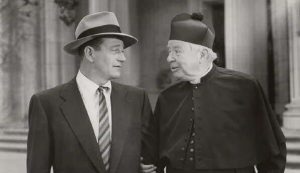 5. The Duke and the Madonna
5. The Duke and the Madonna 6. The Borg and the Borg
6. The Borg and the Borg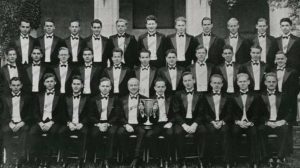
 8. The Roosevelt Shovel and Oak
8. The Roosevelt Shovel and Oak 9. All Numbers Equal 47
9. All Numbers Equal 47